The Specialty Shortenings Market is estimated to be valued at USD 5.2 billion in 2025 and is projected to reach USD 8.2 billion by 2035, registering a compound annual growth rate (CAGR) of 4.5% over the forecast period.
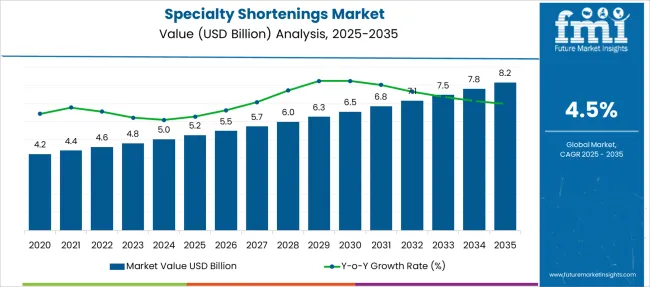
| Metric | Value |
|---|---|
| Specialty Shortenings Market Estimated Value in (2025 E) | USD 5.2 billion |
| Specialty Shortenings Market Forecast Value in (2035 F) | USD 8.2 billion |
| Forecast CAGR (2025 to 2035) | 4.5% |
The specialty shortenings market is experiencing robust growth driven by evolving consumer preferences for clean label ingredients, improved product functionality, and health oriented reformulations across the food and beverage industry. The demand for alternatives to traditional fats has intensified due to increasing concerns around trans fats, cholesterol levels, and nutritional quality.
Food manufacturers are investing in specialty shortenings that enhance texture, shelf life, and mouthfeel without compromising on health benefits. Technological advancements in fat structuring and interesterification processes have enabled the creation of custom blends suited for specific applications.
Regulatory frameworks across major regions advocating for healthier fat compositions are further influencing reformulation strategies. As a result, specialty shortenings are becoming integral to the development of bakery, beverage, and snack products, with continued market expansion expected through innovation, functional versatility, and alignment with health conscious consumption patterns.
The market is segmented by Product Type, Application, Packaging, Function, and Sales Channel and region. By Product Type, the market is divided into Starch Hydrolysis and Sucrose Hydrolysis. In terms of Application, the market is classified into Beverages, Sports Drinks, Health Drinks, Soft Drinks, Nutritional Bars, Confectionery, Ice Creams, Frozen Foods, Dairy Products, Cereals, Bakery Products, Reduced-Calorie Foods, Powdered Beverage Mixes, Shelf-stable Foods, Fruit Preserves, and Marmalades. Based on Packaging, the market is segmented into Craft Paper Bags, Drums, Jars, and Others. By Function, the market is divided into Sweetening, Flavor Enhancer, and Texturing. By Sales Channel, the market is segmented into Direct Sales/B2B, Indirect Sales/B2C, Supermarket/Hypermarket, Retail Stores, Specialty Stores, General Grocery Stores, and Online Stores. Regionally, the market is classified into North America, Latin America, Western Europe, Eastern Europe, Balkan & Baltic Countries, Russia & Belarus, Central Asia, East Asia, South Asia & Pacific, and the Middle East & Africa.
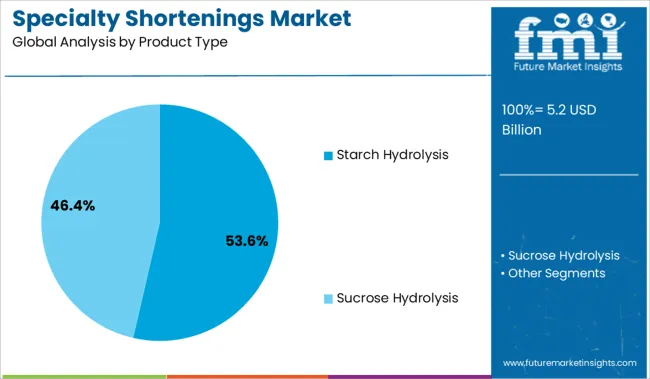
The starch hydrolysis segment is projected to account for 53.60% of total market revenue by 2025 within the product type category, making it the dominant segment. This growth is supported by its superior functionality in improving consistency, sweetness balance, and moisture retention across a wide array of processed foods.
Starch hydrolysis based shortenings are particularly favored for their ability to provide controlled crystallization and uniform texture in baked goods and snacks. Their compatibility with clean label formulations and ease of integration into existing production lines have further reinforced adoption.
As manufacturers seek ingredient solutions that deliver both functional and nutritional value, starch hydrolysis remains the preferred option in specialty fat applications.
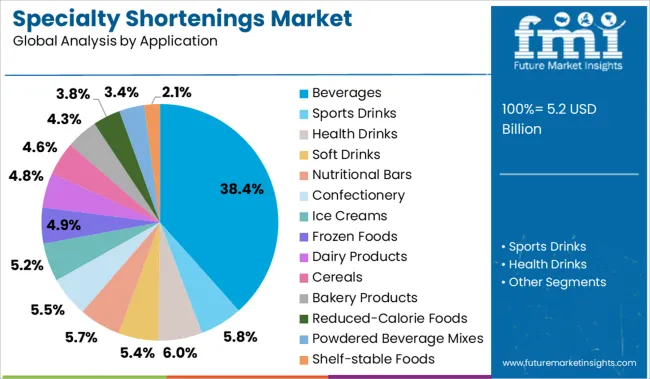
The beverages segment is anticipated to represent 38.40% of total market revenue by 2025 under the application category, establishing it as a leading area of use. This expansion is being driven by rising incorporation of emulsified and creamy textures in ready to drink formulations and functional beverages.
Specialty shortenings are increasingly used to enhance mouthfeel, stability, and appearance in dairy based and plant based drinks. The segment has also benefited from increased demand for meal replacement shakes and protein enriched beverages, where fat structuring is crucial for sensory appeal.
With beverage manufacturers focusing on improving product experience while meeting health trends, the use of specialty shortenings in this category is expected to maintain its upward momentum.
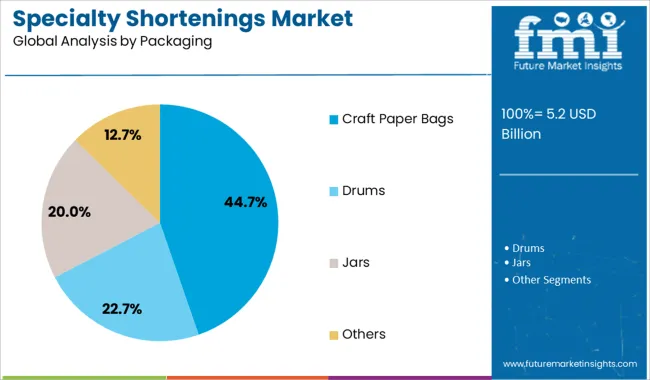
The craft paper bags segment is expected to capture 44.70% of total market revenue by 2025 within the packaging category, making it the top choice among packaging formats. This is due to the increasing push toward sustainable and biodegradable packaging solutions across the food processing and distribution sectors.
Craft paper bags offer an eco friendly, cost effective, and recyclable alternative to plastic based materials, aligning with consumer and regulatory demand for greener packaging. Their ability to maintain product freshness, prevent leakage, and provide a natural aesthetic appeal has led to widespread adoption in both retail and foodservice channels.
The alignment of craft paper bags with circular economy goals continues to reinforce their leadership in the specialty shortenings packaging segment.
The increasing popularity of plant-based ingredients has resulted in an additional opportunity for plant-based specialty shortenings in the global specialty shortenings market. Besides, the increasing consumption of processed food and beverage industries across the globe is fuelling the global specialty shortenings market.
Processed food items such as noodles and pasta are consumed as staple foods in some nations. The preparation time is less for dried noodles, pasta, dry-ready meals, and several other processed food products. The specialty shortenings in bread products are usually used for varied functional benefits such as higher smoke points, improved elasticity, and better shelf life.
Plant-based specialty shortenings are derived from vegetable oils such as sunflower oil, palm oil, rapeseed oil, olive oil, soybean oil, and coconut oil. Animal-derived specialty shortenings are extracted from rendered animal fats like tallow and lard. Plant-based shortenings are experiencing greater demand owing to their several health benefits as compared to animal-derived shortenings. Also, due to the growing vegan population across the world and rising health awareness among consumers, the plant-based segment is anticipated to witness a bigger market share.
Increasing consumption of chocolate is also driving the global specialty shortenings market. There is a demand for chocolate across the globe owing to its stress-relieving and mood-uplifting qualities; this has positively impacted the rise in the demand for specialty shortenings.
Specialty shortenings are also used in several other industries apart from food and beverage, such as personal care, cosmetics, and pharmaceutical products. The demand for personal care and cosmetics is constantly increasing around the world due to rising consumer awareness pertaining to better access.
The development of cosmetics and personal care products that are gender-specific is leading to the growth of the cosmetic industry. Therefore, there is also an upsurge in demand for specialty shortenings in the worldwide market.
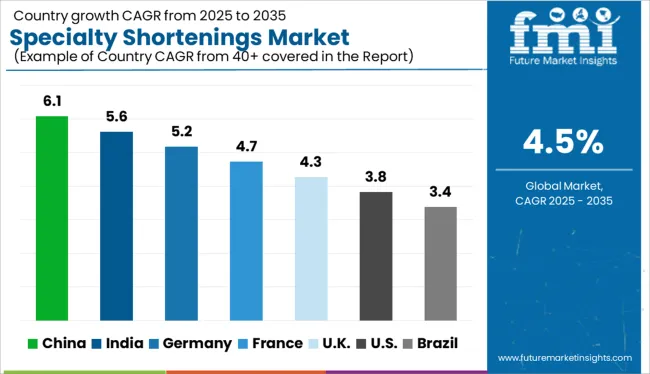
In the global specialty shortenings market, region-wise, North America and Europe account for the major market share. Consumer adoption of goods and products such as cosmetics and personal care, processed foods and beverages, and pharmaceuticals is higher in European and North American countries.
In 2024, Europe attributed the maximum market share owing to the increasing trend of confectionary and freshly baked products in the markets like cake, bread, dried noodles, etc. Nevertheless, the Asia Pacific and the Middle East, and Africa regions are said to experience the biggest growth rate during the forecast period in the global specialty shortenings market.
Factors like ease of access to consumer goods and the majority population shifting from rural areas to urban areas are contributing to the market growth and demand for specialty shortenings in the Asia Pacific and the Middle East and Africa regions.
The young population in the Asia Pacific is portraying more interest in baked and confectionary items, and altering their eating lifestyle is propelling this region to be the fast-growing region in the specialty shortening market.
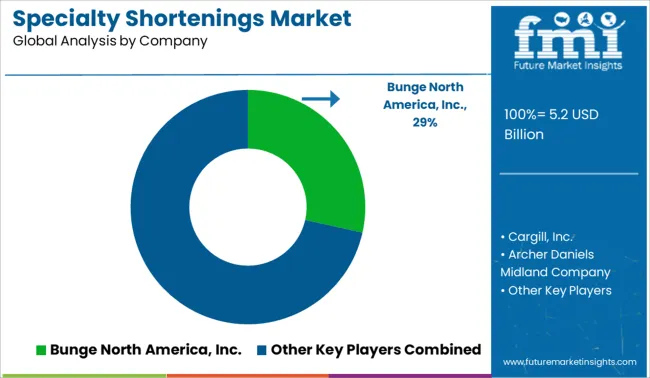
A few of the key players in the Specialty Shortenings market include Bunge North America, Inc., Cargill, Inc., Archer Daniels Midland Company, Ventura Foods, Musim Mas Holdings Pte. Ltd., Sime Darby Kempas Sdn. Bhd., and Tate & Lyle Plc.
Key market players in the specialty shortening market have implemented business expansion and novel product launches as their strategic developmental strategies to develop their market share, enhance profitability, and continue competing in the market. In April 2025, Cargill, Inc. is said to develop the nutrient research and development abilities of its Global Animal Nutrition Innovation Centre to serve food and agriculture, industry customers.
| Report Attribute | Details |
|---|---|
| Growth Rate | CAGR of 4.5% from 2025 to 2035 |
| Base Year for Estimation | 2024 |
| Historical Data | 2020 to 2024 |
| Forecast Period | 2025 to 2035 |
| Quantitative Units | Revenue in USD Million, Volume in Kilotons, and CAGR from 2025 to 2035 |
| Report Coverage | Revenue Forecast, Volume Forecast, Company Ranking, Competitive Landscape, Growth Factors, Trends, and Pricing Analysis |
| Segments Covered | Form, Source, End Use, Distribution Channel |
| Regions Covered | North America; Latin America; Europe; East Asia; South Asia; Oceania; Middle East and Africa |
| Key Countries Profiled | USA, Canada, Brazil, Argentina, Germany, United Kingdom, France, Spain, Italy, Nordics, BENELUX, Australia & New Zealand, China, India, ASIAN, GCC Countries, South Africa |
| Key Companies Profiled | Bunge North America, Inc.; Cargill, Inc.; Archer Daniels Midland Company; Ventura Foods; Musim Mas Holdings Pte. Ltd.; Sime Darby Kempas Sdn. Bhd.; Tate & Lyle Plc. |
| Customization | Available Upon Request |
The global specialty shortenings market is estimated to be valued at USD 5.2 billion in 2025.
The market size for the specialty shortenings market is projected to reach USD 8.2 billion by 2035.
The specialty shortenings market is expected to grow at a 4.5% CAGR between 2025 and 2035.
The key product types in specialty shortenings market are starch hydrolysis and sucrose hydrolysis.
In terms of application, beverages segment to command 38.4% share in the specialty shortenings market in 2025.






Our Research Products

The "Full Research Suite" delivers actionable market intel, deep dives on markets or technologies, so clients act faster, cut risk, and unlock growth.

The Leaderboard benchmarks and ranks top vendors, classifying them as Established Leaders, Leading Challengers, or Disruptors & Challengers.

Locates where complements amplify value and substitutes erode it, forecasting net impact by horizon

We deliver granular, decision-grade intel: market sizing, 5-year forecasts, pricing, adoption, usage, revenue, and operational KPIs—plus competitor tracking, regulation, and value chains—across 60 countries broadly.

Spot the shifts before they hit your P&L. We track inflection points, adoption curves, pricing moves, and ecosystem plays to show where demand is heading, why it is changing, and what to do next across high-growth markets and disruptive tech

Real-time reads of user behavior. We track shifting priorities, perceptions of today’s and next-gen services, and provider experience, then pace how fast tech moves from trial to adoption, blending buyer, consumer, and channel inputs with social signals (#WhySwitch, #UX).

Partner with our analyst team to build a custom report designed around your business priorities. From analysing market trends to assessing competitors or crafting bespoke datasets, we tailor insights to your needs.
Supplier Intelligence
Discovery & Profiling
Capacity & Footprint
Performance & Risk
Compliance & Governance
Commercial Readiness
Who Supplies Whom
Scorecards & Shortlists
Playbooks & Docs
Category Intelligence
Definition & Scope
Demand & Use Cases
Cost Drivers
Market Structure
Supply Chain Map
Trade & Policy
Operating Norms
Deliverables
Buyer Intelligence
Account Basics
Spend & Scope
Procurement Model
Vendor Requirements
Terms & Policies
Entry Strategy
Pain Points & Triggers
Outputs
Pricing Analysis
Benchmarks
Trends
Should-Cost
Indexation
Landed Cost
Commercial Terms
Deliverables
Brand Analysis
Positioning & Value Prop
Share & Presence
Customer Evidence
Go-to-Market
Digital & Reputation
Compliance & Trust
KPIs & Gaps
Outputs
Full Research Suite comprises of:
Market outlook & trends analysis
Interviews & case studies
Strategic recommendations
Vendor profiles & capabilities analysis
5-year forecasts
8 regions and 60+ country-level data splits
Market segment data splits
12 months of continuous data updates
DELIVERED AS:
PDF EXCEL ONLINE
Specialty Film Market Size and Share Forecast Outlook 2025 to 2035
Specialty Silica Market Size and Share Forecast Outlook 2025 to 2035
Specialty Food Ingredients Market Size and Share Forecast Outlook 2025 to 2035
Specialty Polymers Market Size and Share Forecast Outlook 2025 to 2035
Specialty Commercial Deep Fryers Market Size and Share Forecast Outlook 2025 to 2035
Specialty Tapes Market Size and Share Forecast Outlook 2025 to 2035
Specialty Fertilizers Market Size and Share Forecast Outlook 2025 to 2035
Specialty Coatings Market Size and Share Forecast Outlook 2025 to 2035
Specialty Transformer Market Size and Share Forecast Outlook 2025 to 2035
Specialty Chemicals Market Size and Share Forecast Outlook 2025 to 2035
Specialty Nitriles Market Size and Share Forecast Outlook 2025 to 2035
Specialty Fuel Additives Market Size and Share Forecast Outlook 2025 to 2035
Specialty Cultures Market Analysis - Size, Share and Forecast Outlook 2025 to 2035
Specialty Labels Packaging Market Size and Share Forecast Outlook 2025 to 2035
Specialty Commercial Vehicle Market Size and Share Forecast Outlook 2025 to 2035
Specialty Carbon Black Market Size and Share Forecast Outlook 2025 to 2035
Specialty Lighting Market Size and Share Forecast Outlook 2025 to 2035
Specialty Amino Acids Market Size and Share Forecast Outlook 2025 to 2035
Specialty Pulp & Paper Chemicals Market Size, Share & Forecast 2025 to 2035
Specialty Yeast Market Analysis - Size, Growth, and Forecast 2025 to 2035

Thank you!
You will receive an email from our Business Development Manager. Please be sure to check your SPAM/JUNK folder too.
Chat With
MaRIA